The Intel Xeon W-3175X Review: 28 Unlocked Cores, $2999
by Ian Cutress on January 30, 2019 9:00 AM ESTCPU Performance: Office Tests
The Office test suite is designed to focus around more industry standard tests that focus on office workflows, system meetings, some synthetics, but we also bundle compiler performance in with this section. For users that have to evaluate hardware in general, these are usually the benchmarks that most consider.
All of our benchmark results can also be found in our benchmark engine, Bench.
For our graphs, some of them have two values: a regular value in orange, and one in red called 'Intel Spec'. ASUS offers the option to 'open up' the power and current limits of the chip, so the CPU is still running at the same frequency but is not throttled. Despite Intel saying that they recommend 'Intel Spec', the system they sent to us to test was actually set up with the power limits opened up, and the results they provided for us to compare to internally also correlated with that setting. As a result, we're providing both sets results for our CPU tests.
PCMark 10: Industry Standard System Profiler
Futuremark, now known as UL, has developed benchmarks that have become industry standards for around two decades. The latest complete system test suite is PCMark 10, upgrading over PCMark 8 with updated tests and more OpenCL invested into use cases such as video streaming.
PCMark splits its scores into about 14 different areas, including application startup, web, spreadsheets, photo editing, rendering, video conferencing, and physics. We post all of these numbers in our benchmark database, Bench, however the key metric for the review is the overall score.
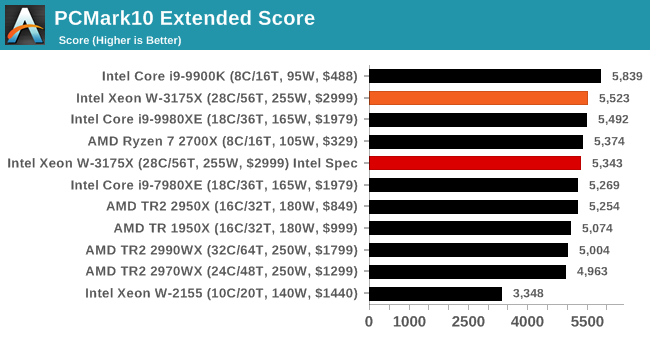
.
Chromium Compile: Windows VC++ Compile of Chrome 56
A large number of AnandTech readers are software engineers, looking at how the hardware they use performs. While compiling a Linux kernel is ‘standard’ for the reviewers who often compile, our test is a little more varied – we are using the windows instructions to compile Chrome, specifically a Chrome 56 build from March 2017, as that was when we built the test. Google quite handily gives instructions on how to compile with Windows, along with a 400k file download for the repo.
In our test, using Google’s instructions, we use the MSVC compiler and ninja developer tools to manage the compile. As you may expect, the benchmark is variably threaded, with a mix of DRAM requirements that benefit from faster caches. Data procured in our test is the time taken for the compile, which we convert into compiles per day.
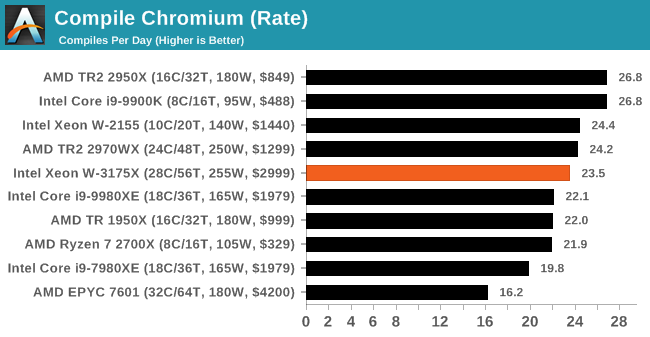
.
3DMark Physics: In-Game Physics Compute
Alongside PCMark is 3DMark, Futuremark’s (UL’s) gaming test suite. Each gaming tests consists of one or two GPU heavy scenes, along with a physics test that is indicative of when the test was written and the platform it is aimed at. The main overriding tests, in order of complexity, are Ice Storm, Cloud Gate, Sky Diver, Fire Strike, and Time Spy.
Some of the subtests offer variants, such as Ice Storm Unlimited, which is aimed at mobile platforms with an off-screen rendering, or Fire Strike Ultra which is aimed at high-end 4K systems with lots of the added features turned on. Time Spy also currently has an AVX-512 mode (which we may be using in the future).
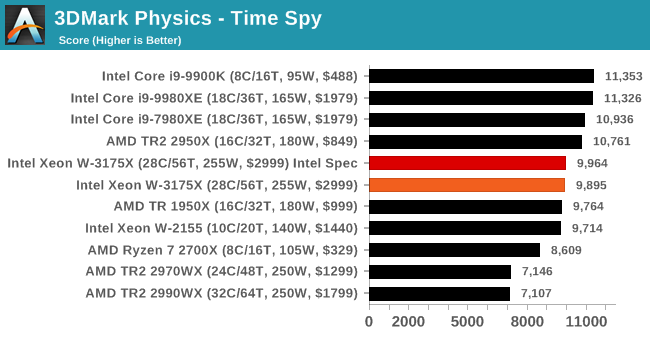
.
GeekBench4: Synthetics
A common tool for cross-platform testing between mobile, PC, and Mac, GeekBench 4 is an ultimate exercise in synthetic testing across a range of algorithms looking for peak throughput. Tests include encryption, compression, fast Fourier transform, memory operations, n-body physics, matrix operations, histogram manipulation, and HTML parsing.
I’m including this test due to popular demand, although the results do come across as overly synthetic, and a lot of users often put a lot of weight behind the test due to the fact that it is compiled across different platforms (although with different compilers).
We record the main subtest scores (Crypto, Integer, Floating Point, Memory) in our benchmark database, but for the review we post the overall single and multi-threaded results.
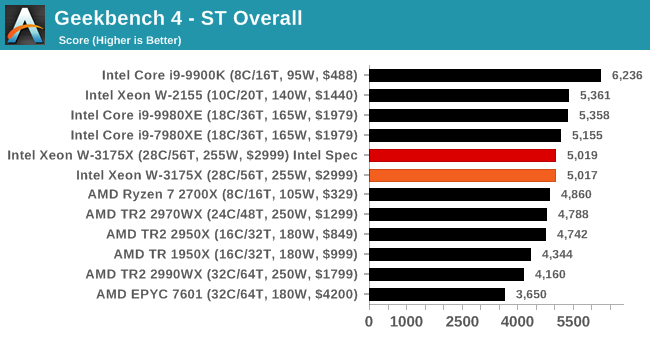
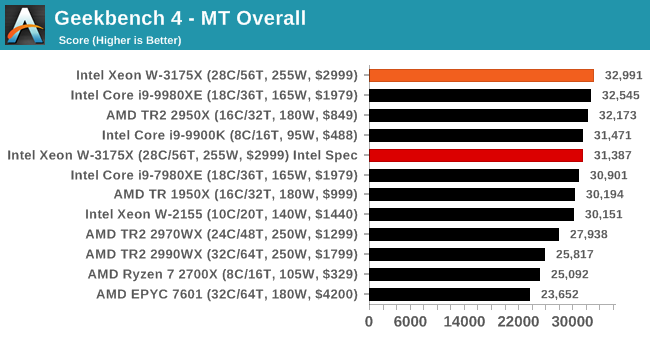










136 Comments
View All Comments
FMinus - Friday, February 1, 2019 - link
Not really, 3D rednering is done on specialized render farms, the modeling work, key framing etc. can be done on any decent modern mainstream CPU, and especially well on any modern HEDT chip, for prototyping and preview, once satisfied, send it out to render properly.eastcoast_pete - Wednesday, January 30, 2019 - link
The only scenario where this or similar Xeons do outperform the AMD lineup is if (!) the key application (s) in question make good use of AVX512. In those situations, Intel is still way ahead. In all others, a similar or lower priced Threadripper will give more bang for the buck.Tango - Wednesday, January 30, 2019 - link
There are scenarios in which this is perfect, and in fact my research department is looking into acquiring two of them. Our algorithms include both highly parallelized instructions and completely non parallelizable ones where clock speed dominates. We estimate models that take a whole weekend to spot out a result, and the alternative is paying top money for supercomputer time.At $3000 it is a steal. The problem is half Wall Street will be sending orders to get one, since the use case is similar for high frequency trading applications.
MattZN - Wednesday, January 30, 2019 - link
I expect all the review sites will redo their 2990WX benchmarks once Microsoft is able to fix the scheduler. The question is really... how long will it take Microsoft to fix their scheduler? That said, nobody should be expecting massive improvements. Some of the applications will improve a ton, but not all of them. It will be more like a right-sizing closer to expected results and less like hitting the ball out of the park.-Matt
BGADK - Wednesday, January 30, 2019 - link
Little professional software exists for Linux, so these machines WILL run windows for most parts.cmcl - Thursday, January 31, 2019 - link
Agree that there is more professional software for Windows, but in visual effects (where I work), 90% of our workstations (and all render) runs on Linux (24-core workstations, with P6000s), running Nuke, Maya etc. Apart from the gaming benchmarks (and who would buy one of these for gaming), a lot of the tests could be done in Linux as that software runs on LinuxIcehawk - Thursday, January 31, 2019 - link
Workstations aside, these mega-core beasts are run as VM hosts on bare metal. I don't have a single server here that just runs an OS & app suite, it's not 2000 anymore everything is virtualized as much as possible.WasHopingForAnHonestReview - Wednesday, January 30, 2019 - link
Holy shit. AMD absolutely bent intel over on this one. The price for performance ratio is overwhelming in AMD ls favor! Intel would have released this for 8k if the 2990wx wasnt so competitive!WOW!
GreenReaper - Thursday, January 31, 2019 - link
They probably wouldn't have released it at all. As noted, most of these could easily be server cores on which they could make plenty more money. This appears to be largely a PR effort.jcc5169 - Wednesday, January 30, 2019 - link
Who in the world would buy this over-priced piece-of-crap?